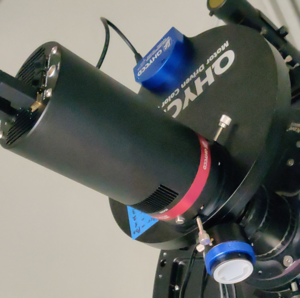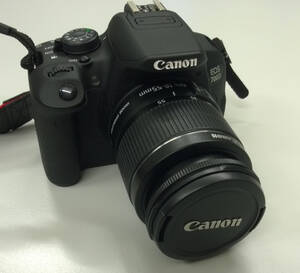This is an old revision of the document!
Specialized astro cameras
CMOS cameras
Our newcomer, the QHY 600M is a CMOS camera that was developed especially for astrophotography. It is our new deep-sky camera and offers among other things a full format sensor, a very high quantum efficiency, a very low readout noise and a very low dark current. For this camera we also have an off-axis-guide and a filter wheel with 9 positions.
CCD Cameras
Furthermore, four CCD cameras (ST-7, ST-8, STF-8300M, ST-i) from SBIG (Santa Barbara Instrument Group) and one CCD camera (Skyris 445C) from Celestron are available.
The ST-7 and ST-8 are deep-sky cameras, but due to their relatively small field of view they are rarely used. The STF-8300M is used as main camera for our two Spektrographs.
The ST-i and the Skyris 445C are “planetary cameras” which allow very short exposure times. They are mainly used as guiding cameras (see e.g. here or here) in connection with the QHY 600M and the spectrographs.
All cameras can be controlled via Maxim DL. For the SBIG cameras CCDOPS is also available as control software.
Basic data
Main cameras
| ST-7 | ST-8 | STF-8300 | QHY 600M | |
| Model number | ST-7XME-D | ST-8XME | STF-8300M | QHY 600M PRO-L |
| pixel size | 9 $\mu \text{m}$ x 9 $\mu \text{m}$ | 9 $\mu \text{m}$ x 9 $\mu \text{m}$ | 5.4 $\mu \text{m}$ x 5.4 $\mu \text{m}$ | 3.76 $\mu \text{m}$ x 3.76 $\mu \text{m}$ |
| Number of pixels | 765 x 510 | 1530 x 1020 | 3326 x 2504 | 9576 x 6388 |
| Total size of the chip | 6.9 mm x 4.6 mm | 13.8 mm x 9.2 mm | 17.96 mm x 13.52 mm | 36 mm x 24 mm |
| Field of view with the CDK20 | 6.9’ x 4.6’ | 13.7’ x 9.2’ | 17.9’ x 13.5’ | 35.8’ x 23.4’ |
| Sampling | 1.9 Pixel per arcsec | 1.9 Pixel per arcsec | 3.1 Pixel per arcsec | 4.5 Pixel per arcsec |
Planetary/Guiding cameras
| Skyris 445 | ST-i | |
| Model number | Skyris 445C | ST-i monochrome |
| pixel size | 3.75 $\mu \text{m}$ x 3.75 $\mu \text{m}$ | 7.4 $\mu \text{m}$ x 7.4 $\mu \text{m}$ |
| Number of pixels | 1280 x 960 | 648 x 486 |
| Total size of the chip | 6.26 mm x 5.01 mm | 4.8 mm x 3.6 mm |
| Field of view with the CDK20 | 6.2’ x 5.0’ | 4.8’ x 3.6’ |
| Sampling | 3.4 Pixel per arcsec | 2.3 Pixel per arcsec |
Filter wheels
QHY 600M
For the new QHY 600M we have installed the following filters in the filter wheel:
| Filter position | 1 | 2 | 3 | 4 | 5 | 6 | 7 | 8 | 9 |
| Filter | H_alpha | OIII | SII | U | B | V | R | I | Clear |
| Comment | narrow band | narrow band | narrow band | broad band | broad band | broad band | broad band | broad band |
ST-7 & ST-8
A filter wheel with the following filters can be attached to the ST-7 and ST-8:
| Filter position | 1 | 2 | 3 | 4 | 5 | 6 | 7 | 8 | 9 | 10 |
| Filter | U | B | V | R | I | H_beta | H_alpha | SII | OIII | EMPTY |
| Comment | broad band | broad band | broad band | broad band | broad band | narrow band | narrow band | narrow band | narrow band |
The transmission curves of the UBVRI filters can be found at the web page of Baader Planetarium: Filter transmission. The transmission curves of the narrow band filter are similar to those of the STF8300.
STF-8300
For the STF-8300 a filter wheel with the following filters is available:
| Filter position | 1 | 2 | 3 | 4 | 5 | 6 | 7 | 8 |
| Filter | Block-UV/IR (L) | Blue | Green | Red | H_alpha | OIII | V | B |
| Comment | luminance | broad band | broad band | broad band | narrow band | narrow band | broad band | broad band |
The transmission curves of the new filters can be found at the web page of Baader Planetarium: Filter transmission.
The transmission curves of the V and B filters are identical with the V and B filters used in the ST-7.
Features
- For the ST-7 and ST-8 we have an adaptive optics module, the AO-7, which can be used for guiding and to optimize the exposure quality (see e.g. here).
- The ST-7 and ST-8 contain an additional guiding chip in addition to the normal CCD chip, which can be used to automatically track an object (see e.g. here), while the main CCD can be used to take the actual image.
- The Off Axis Guides of the STF-8300 and the QHY 600M have the advantage that they are placed in front of the respective filter wheel and therefore the guiding is independent of the brightness of the guide star in the respective filter. For this reason, these cameras can make use of fainter guide stars/objects in comparison to the ST-7 and ST-8.
Maintenance
Every 12 months (or before) the desiccant cartouches of the cameras need to be regenerated (baked), otherwise there's the possibility that the cooled CCD sensors can suffer from icing due to moisture in the cameras. The desiccant cartouches of the ST-7 and ST-8 can be found at the bottom of the camera and can easily be released from the camera case with a screw driver. This procedure is even easier for the STF-8300, where the desiccant cartouche (located at one side of the camera) can be unscrew with two fingers. Attention! The connection between the camera cases and desiccant cartouches are secured by sealing rings that can easily fall off the cartouches and vanish inside the camera cases. To prevent water (vapor) from getting into the camera during the regeneration of its desiccant cartouche, remove the desiccant cartouche in a dry environment and replace it with one of the dummies, which can be found in the room 2.009. It takes about four hours at 170°C in a common oven (without the sealing ring!) to regenerate the desiccant in the cartouche, so that the camera can work for another year without icing.
DSLR
For short time exposures and lucky imaging there is the digital (single) reflex camera (DSLR): Canon EOS 700D. It has been optimized for amateur astronomers by Baader Planetarium by changing the used filters. The transmission properties of the original Canon filters in comparison to the optimized ones can be found at the Baader web page click to view the image.
Basic data
| EOS 700D | |
| Image sensor | CMOS sensor |
| Size of the pixels | 4.3 $\mu \text{m}$ x 4.3 $\mu \text{m}$ |
| Number of pixels | 5,184 x 3,456 |
| Total size of the chip | APS-C 22.3 $\text{mm}$ x 14.9 $\text{mm}$ |
| Format factor and Axe ratio | 1.6 and 3:2 |
| Field of view with the Celestron C14 | 19.6’ x 13.1’ |
| Field of view with the Celestron C11 | 27.4' x 18.3' |
| Field of view with the Celestron C11 + F/6.3 focal reducer | 43.5' x 29.0' |
| Field of view with the Celestron C8 | 37.7' x 25.2' |
| Field of view with the Celestron C8 + F/6.3 focal reducer | 59.9' x 40.0' |
| Exposure times | 30-1/4,000 $\text{s}$ (halves or thirds of steps) |
| ISO-Sensitivity | 100–12,800 (can be expanded up to 25,600) |
Furthermore, one can take full-HD videos with an ISO sensitivity of max. 6,400 (can be expanded up to 12,800). The camera can be controlled by a rotatable and slewable 7,7 cm LCD touchscreen or by a computer interface. Exposure series can be taken at a maximum speed of approx. 5 images per second, which can be maintained for about 22 exposures (JPEG format) or 6 exposures (RAW format).


